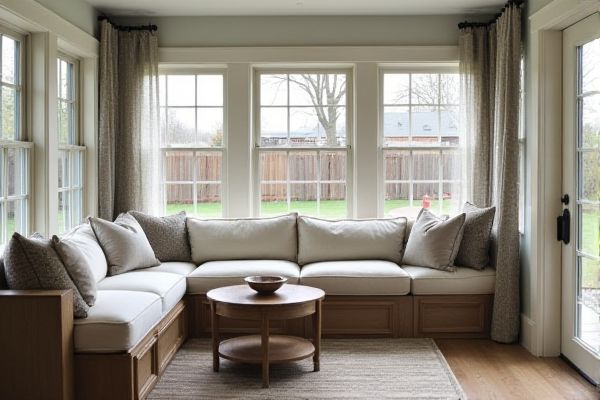
Modular seating offers flexibility and easy rearrangement, making it ideal for adapting your sunroom to different occasions, while built-in banquettes provide a seamless, space-saving design with a customized aesthetic that enhances the room's architecture. Discover which option best suits your lifestyle and sunroom layout by exploring the full article.
Table of Comparison
| Feature | Modular Seating | Built-in Banquette (Sunroom) |
|---|---|---|
| Flexibility | Highly adjustable, can be rearranged | Fixed seating, permanent placement |
| Space Utilization | Uses versatile seating configurations | Optimizes corner and wall space efficiently |
| Installation | No installation, movable | Requires professional installation |
| Customization | Easy to swap or add pieces | Custom-designed to fit specific dimensions |
| Comfort | Varies by cushion and setup | Integrated cushions, tailored comfort |
| Durability | Depends on materials, less sturdy | Long-lasting, built into structure |
| Cost | Generally lower upfront cost | Higher initial investment |
| Cleaning & Maintenance | Easy to clean and move | Requires specific care due to fixed build |
| Style | Modern and adaptable to trends | Classic and tailored to sunroom design |
Introduction to Sunroom Seating Options
Modular seating offers flexible arrangements that can be easily customized to fit the unique dimensions and changing needs of your sunroom, enhancing comfort and style. Built-in banquettes provide a permanent, space-saving solution that maximizes seating while adding a cohesive, tailored look to the space. Choosing between these options depends on your preference for adaptability versus integrated design in your sunroom's seating arrangement.
What is Modular Seating?
Modular seating consists of individual, movable pieces that can be arranged to fit various spaces, offering flexibility for your sunroom layout. Unlike a built-in banquette, modular seating allows easy reconfiguration or relocation to adapt to changing needs or occasions. Its adaptability makes it ideal for creating customized seating arrangements without permanent installation.
Understanding Built-in Banquettes
Built-in banquettes in sunrooms offer customized, space-saving seating that integrates seamlessly with the room's architecture, providing a permanent and sturdy solution often enhanced with storage compartments underneath. Unlike modular seating, built-in banquettes allow for tailored upholstery and dimensions that perfectly fit the sunroom's design, boosting both comfort and aesthetic appeal. These installations increase functionality by maximizing natural light exposure and creating a cozy, inviting atmosphere ideal for dining or relaxation.
Space Efficiency: Modular vs Banquette
Modular seating offers superior space efficiency in a sunroom by allowing flexible arrangement and easy reconfiguration to suit various activities and room sizes. Built-in banquettes maximize space by integrating seating directly into the architecture, often including storage beneath, but lack the adaptability of modular units. Choosing between modular seating and a built-in banquette depends on the need for versatility versus maximizing fixed, compact seating solutions.
Style and Aesthetic Flexibility
Modular seating offers exceptional style and aesthetic flexibility by allowing customization in shapes, colors, and configurations to match various sunroom designs. Built-in banquettes provide a fixed, cohesive look that seamlessly integrates with architectural features, offering a timeless and tailored appearance. Opting for modular seating facilitates easy updates and reconfigurations, while built-in banquettes emphasize permanence and structural elegance in sunroom decor.
Comfort and Ergonomics Comparison
Modular seating in sunrooms offers customizable comfort with adjustable components that adapt to various body shapes and seating preferences, enhancing overall ergonomics. Built-in banquettes provide consistent support through fixed designs that maximize space efficiency while maintaining proper posture alignment for long-term seating comfort. Both options prioritize ergonomic benefits, but modular seating allows greater flexibility in cushioning and configuration to suit individual comfort needs.
Installation and Costs
Modular seating in a sunroom offers easy installation with flexible placement options, often requiring minimal tools and time, making it a cost-effective choice for budget-conscious homeowners. Built-in banquettes involve professional carpentry for a custom fit, increasing installation complexity and expenses but providing a seamless, integrated look. Your decision should weigh initial costs against long-term durability and aesthetic preferences for the best investment.
Storage Solutions: Hidden vs Integrated
Modular seating in a sunroom offers hidden storage solutions with compartments that can be easily accessed and reconfigured to maximize space. Built-in banquettes provide integrated storage, seamlessly incorporated into the structure for a streamlined look and consistent design. Both options enhance organization, but modular units prioritize flexibility while built-in banquettes emphasize permanence and style continuity.
Maintenance and Durability
Modular seating in sunrooms offers easy maintenance with removable cushions and washable covers, enhancing durability through replaceable components. Built-in banquettes provide sturdy, long-lasting structures often made from solid wood or custom materials, requiring periodic refinishing to maintain appearance and resist wear. Both options offer durable solutions, but modular seating allows more flexibility in upkeep and replacement of parts.
Which Sunroom Seating is Right for You?
Modular seating in a sunroom offers flexible configurations and easy re-arrangement, ideal for those who prioritize adaptability and seasonal changes. Built-in banquettes provide a sleek, space-saving solution with integrated storage, perfect for maximizing limited sunroom square footage while giving a permanent, polished look. Choosing between modular seating and built-in banquettes depends on your sunroom size, desired versatility, and aesthetic preferences.
 homyna.com
homyna.com